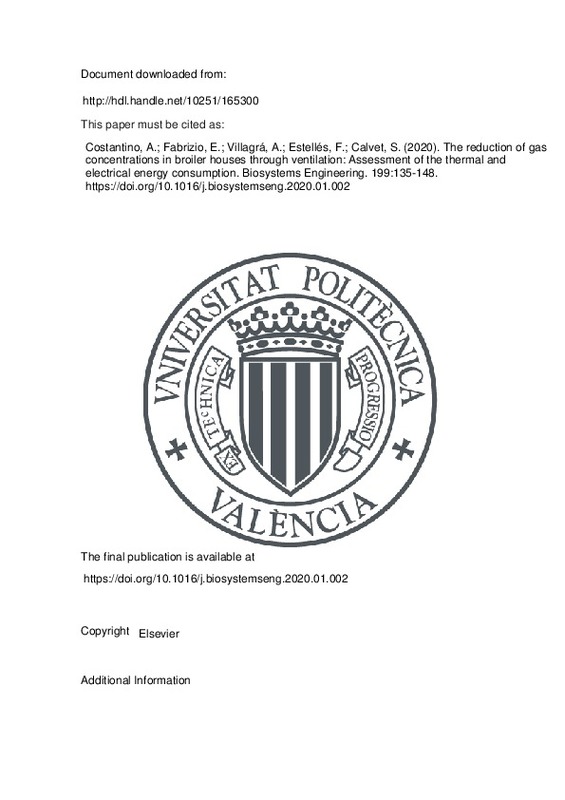Anderson, D. P., Beard, C. W., & Hanson, R. P. (1964). The Adverse Effects of Ammonia on Chickens Including Resistance to Infection with Newcastle Disease Virus. Avian Diseases, 8(3), 369. doi:10.2307/1587967
Beker, A., Vanhooser, S. L., Swartzlander, J. H., & Teeter, R. G. (2004). Atmospheric Ammonia Concentration Effects on Broiler Growth and Performance. Journal of Applied Poultry Research, 13(1), 5-9. doi:10.1093/japr/13.1.5
Calvet, S., Cambra-López, M., Blanes-Vidal, V., Estellés, F., & Torres, A. G. (2010). Ventilation rates in mechanically-ventilated commercial poultry buildings in Southern Europe: Measurement system development and uncertainty analysis. Biosystems Engineering, 106(4), 423-432. doi:10.1016/j.biosystemseng.2010.05.006
[+]
Anderson, D. P., Beard, C. W., & Hanson, R. P. (1964). The Adverse Effects of Ammonia on Chickens Including Resistance to Infection with Newcastle Disease Virus. Avian Diseases, 8(3), 369. doi:10.2307/1587967
Beker, A., Vanhooser, S. L., Swartzlander, J. H., & Teeter, R. G. (2004). Atmospheric Ammonia Concentration Effects on Broiler Growth and Performance. Journal of Applied Poultry Research, 13(1), 5-9. doi:10.1093/japr/13.1.5
Calvet, S., Cambra-López, M., Blanes-Vidal, V., Estellés, F., & Torres, A. G. (2010). Ventilation rates in mechanically-ventilated commercial poultry buildings in Southern Europe: Measurement system development and uncertainty analysis. Biosystems Engineering, 106(4), 423-432. doi:10.1016/j.biosystemseng.2010.05.006
Calvet, S., Estellés, F., Cambra-López, M., Torres, A. G., & Van den Weghe, H. F. A. (2011). The influence of broiler activity, growth rate, and litter on carbon dioxide balances for the determination of ventilation flow rates in broiler production. Poultry Science, 90(11), 2449-2458. doi:10.3382/ps.2011-01580
Costantino, A., Fabrizio, E., Biglia, A., Cornale, P., & Battaglini, L. (2016). Energy Use for Climate Control of Animal Houses: The State of the Art in Europe. Energy Procedia, 101, 184-191. doi:10.1016/j.egypro.2016.11.024
Costantino, A., Fabrizio, E., Ghiggini, A., & Bariani, M. (2018). Climate control in broiler houses: A thermal model for the calculation of the energy use and indoor environmental conditions. Energy and Buildings, 169, 110-126. doi:10.1016/j.enbuild.2018.03.056
Gerritzen, M. A., Lambooij, E., Hillebrand, S. J., Lankhaar, J. A., & Pieterse, C. (2000). Behavioral Responses of Broilers to Different Gaseous Atmospheres. Poultry Science, 79(6), 928-933. doi:10.1093/ps/79.6.928
Gerritzen, M., Lambooij, B., Reimert, H., Stegeman, A., & Spruijt, B. (2007). A note on behaviour of poultry exposed to increasing carbon dioxide concentrations. Applied Animal Behaviour Science, 108(1-2), 179-185. doi:10.1016/j.applanim.2006.11.014
Groot Koerkamp, P. W. G., Metz, J. H. M., Uenk, G. H., Phillips, V. R., Holden, M. R., Sneath, R. W., … Wathes, C. M. (1998). Concentrations and Emissions of Ammonia in Livestock Buildings in Northern Europe. Journal of Agricultural Engineering Research, 70(1), 79-95. doi:10.1006/jaer.1998.0275
Gustin, P., Urbain, B., Prouvost, J. F., & Ansay, M. (1994). Effects of Atmospheric Ammonia on Pulmonary Hemodynamics and Vascular Permeability in Pigs: Interaction with Endotoxins. Toxicology and Applied Pharmacology, 125(1), 17-26. doi:10.1006/taap.1994.1044
Jones, T. A., Donnelly, C. A., & Stamp Dawkins, M. (2005). Environmental and management factors affecting the welfare of chickens on commercial farms in the United Kingdom and Denmark stocked at five densities. Poultry Science, 84(8), 1155-1165. doi:10.1093/ps/84.8.1155
Knížatová, M., Mihina, Š., Brouček, J., Karandušovská, I., Sauter, G. J., & Mačuhová, J. (2010). Effect of the age and season of fattening period on carbon dioxide emissions from broiler housing. Czech Journal of Animal Science, 55(No. 10), 436-444. doi:10.17221/1701-cjas
Kristensen, H. H., Burgess, L. R., Demmers, T. G. ., & Wathes, C. M. (2000). The preferences of laying hens for different concentrations of atmospheric ammonia. Applied Animal Behaviour Science, 68(4), 307-318. doi:10.1016/s0168-1591(00)00110-6
Kristensen, H. H., & Wathes, C. M. (2000). Ammonia and poultry welfare: a review. World’s Poultry Science Journal, 56(3), 235-245. doi:10.1079/wps20000018
Morsing, S., Strøm, J. S., Zhang, G., & Kai, P. (2008). Scale model experiments to determine the effects of internal airflow and floor design on gaseous emissions from animal houses. Biosystems Engineering, 99(1), 99-104. doi:10.1016/j.biosystemseng.2007.09.028
Olanrewaju, H. A., III, W. A. D., Purswell, J. L., Branton, S. L., Miles, D. M., Lott, B. D., … Thaxton, J. P. (2008). Growth Performance and Physiological Variables for Broiler Chickens Subjected to Short-Term Elevated Carbon Dioxide Concentrations. International Journal of Poultry Science, 7(8), 738-742. doi:10.3923/ijps.2008.738.742
W. Miller, W., R. Maslin, W., P. Thaxton, J., A. Olanrew, H., Dozier, II, W. A., Purswell, J., & L. Branton, S. (2007). Interactive Effects of Ammonia and Light Intensity on Ocular,
Fear and Leg Health in Broiler Chickens. International Journal of Poultry Science, 6(10), 762-769. doi:10.3923/ijps.2007.762.769
Quarles, C. L., & Kling, H. F. (1974). Evaluation of Ammonia and Infectious Bronchitis Vaccination Stress on Broiler Performance and Carcass Quality. Poultry Science, 53(4), 1592-1596. doi:10.3382/ps.0531592
Reindl, D. T., Beckman, W. A., & Duffie, J. A. (1990). Diffuse fraction correlations. Solar Energy, 45(1), 1-7. doi:10.1016/0038-092x(90)90060-p
Ritz, C. W., Fairchild, B. D., & Lacy, M. P. (2004). Implications of Ammonia Production and Emissions from Commercial Poultry Facilities: A Review. Journal of Applied Poultry Research, 13(4), 684-692. doi:10.1093/japr/13.4.684
Thornton, P. K. (2010). Livestock production: recent trends, future prospects. Philosophical Transactions of the Royal Society B: Biological Sciences, 365(1554), 2853-2867. doi:10.1098/rstb.2010.0134
Valentine, H. (1964). A study of the effect of different ventilation rates on the ammonia concentrations in the atmosphere of broiler houses. British Poultry Science, 5(2), 149-159. doi:10.1080/00071666408415526
Verspecht, A., Vanhonacker, F., Verbeke, W., Zoons, J., & Van Huylenbroeck, G. (2011). Economic impact of decreasing stocking densities in broiler production in Belgium. Poultry Science, 90(8), 1844-1851. doi:10.3382/ps.2010-01277
C. M. Wathes, J. B. Jones, H. H. Kristensen, E. K. M. Jones, & A. J. F. Webster. (2002). AVERSION OF PIGS AND DOMESTIC FOWL TO ATMOSPHERIC AMMONIA. Transactions of the ASAE, 45(5). doi:10.13031/2013.11067
WEAVER, W. D., & MEIJERHOF, R. (1991). The Effect of Different Levels of Relative Humidity and Air Movement on Litter Conditions, Ammonia Levels, Growth, and Carcass Quality for Broiler Chickens. Poultry Science, 70(4), 746-755. doi:10.3382/ps.0700746
Yi, B., Chen, L., Sa, R., Zhong, R., Xing, H., & Zhang, H. (2016). Transcriptome Profile Analysis of Breast Muscle Tissues from High or Low Levels of Atmospheric Ammonia Exposed Broilers (Gallus gallus). PLOS ONE, 11(9), e0162631. doi:10.1371/journal.pone.0162631
Zhang, Y., & Barber, E. M. (1995). An Evaluation of Heating and Ventilation Control Strategies for Livestock Buildings. Journal of Agricultural Engineering Research, 60(4), 217-225. doi:10.1006/jaer.1995.1016
[-]







![[Cerrado]](/themes/UPV/images/candado.png)


